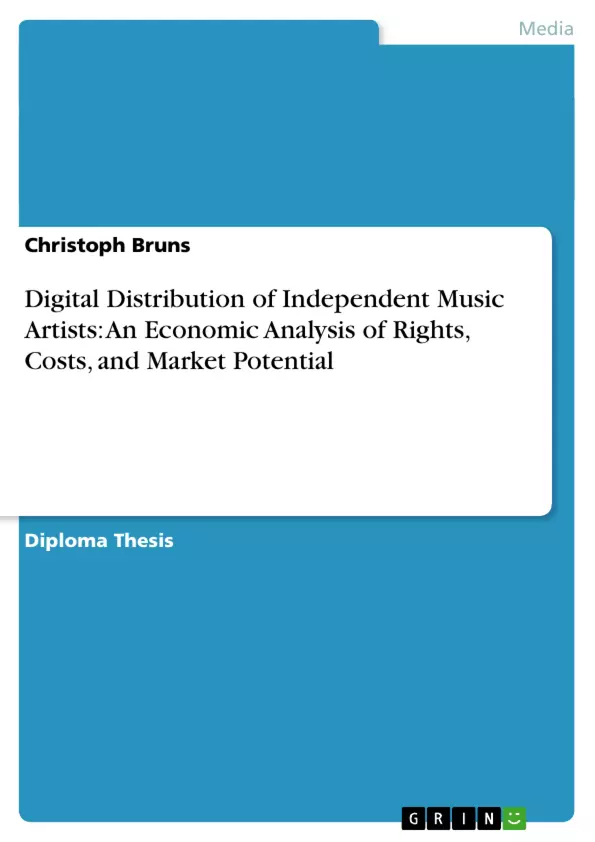This thesis considers the influence of digital distribution on the independent music artists’
position in the value chain with respect to rights, costs, and market potential from the
perspective of an economic analysis. It begins by delineating the relevant terms and
providing a research background about the digital distribution of independent music artists.
Ongoing, a new analytical framework is introduced in order to guide the economic
analyses from rights and costs to the market potential, whereas direct and indirect
distribution are compared from the independent music artists’ point of view. It is found
that digital distribution encourages independent music artists to enter the music market
without the necessity of a major label. Furthermore, digital distribution seems to be an
attractive way for unpopular artists to increase their awareness regardless likely copyright
infringements.
Inhaltsverzeichnis (Table of Contents)
- 1. Introduction
- 2. Delineation of Terms
- 2.1 Digital Distribution
- 2.2 Independent Music Artists
- 3. Research Background: Digital Distribution of Independent Music Artists
- 3.1 Market Size
- 3.2 Players and Value Chain
- 3.2.1 Artists
- 3.2.2 Labels
- 3.2.3 Aggregators
- 3.2.3 Digital Retailers
- 3.2.4 Collection Societies
- 3.2.5 Consumers
- 3.3 Revenue Split as a Business Model
- 4. Analytical Framework
- 4.1 Rights
- 4.1.1 The German Copyright Law and Related Rights of Independent Music Artists
- 4.1.2 Determinants of the Commercial Copyright Exploitation of Independent Music Artists
- 4.1.2.1 Digital Rights Management-Systems
- 4.1.2.2 Legal Copyright Enforcement
- 4.1.2.3 Versioning
- 4.2 Costs
- 4.2.1 Independent Music Artists Affecting Determinants of Costs
- 4.2.1.1 Product Quality
- 4.2.1.2 Promotional Effort
- 4.2.1.3 Distribution Intensity
- 4.2.1 Independent Music Artists Affecting Determinants of Costs
- 4.1 Rights
- 5. Economic Analysis
- 5.1 Methodology
- 5.2 Economic Analysis of Rights
- 5.2.1 Digital Distribution in the Context of the Property Rights Theory
- 5.2.2 Effects of Lacking Copyright Law Enforcement
- 5.3 Economic Analysis of Costs
- 5.3.1 Production Costs
- 5.3.2 Marketing Costs
- 5.3.3 Distribution Costs
- 5.4 Derived Analysis of the Market Potential
- 6. Discussion
- 7. Critical Appraisal and Outlook
Zielsetzung und Themenschwerpunkte (Objectives and Key Themes)
The primary objective of this thesis is to analyze the economic aspects of digital music distribution for independent music artists. This includes examining the interplay of rights, costs, and the potential market reach for these artists in the digital environment.
- Copyright and related rights of independent music artists
- Economic analysis of costs associated with digital distribution
- Factors influencing the market potential for independent music artists
- Impact of digital rights management and copyright enforcement
- The role of digital retailers, aggregators, and collection societies in the value chain
Zusammenfassung der Kapitel (Chapter Summaries)
- Chapter 1 provides an introduction to the topic of digital distribution of independent music. It establishes the importance of this subject and outlines the structure of the thesis.
- Chapter 2 defines key terms such as digital distribution and independent music artists, setting the foundation for the analysis.
- Chapter 3 delves into the research background by examining the market size, major players, and revenue models in the digital music industry. It explores the value chain and various roles within it.
- Chapter 4 develops an analytical framework by examining rights and costs associated with digital distribution. This chapter analyzes the German copyright law, determinants of commercial copyright exploitation, and costs affecting independent artists.
- Chapter 5 presents an economic analysis of rights and costs, considering the impact of copyright enforcement and the role of different cost components. It also analyzes the market potential for digital distribution.
- Chapter 6 offers a discussion of the findings and insights gained from the economic analysis, exploring the implications for independent music artists.
- Chapter 7 concludes with a critical appraisal and outlook on the future of digital music distribution for independent artists, considering emerging trends and challenges.
Schlüsselwörter (Keywords)
The primary focus of this thesis is on the digital distribution of music by independent artists, encompassing topics such as copyright law, economic analysis of costs, market potential, digital rights management, revenue models, and the impact of digitalization on the music industry. Key players in this field include independent artists, labels, aggregators, digital retailers, and collection societies.
- Citation du texte
- Christoph Bruns (Auteur), 2012, Digital Distribution of Independent Music Artists: An Economic Analysis of Rights, Costs, and Market Potential, Munich, GRIN Verlag, https://www.grin.com/document/204233



